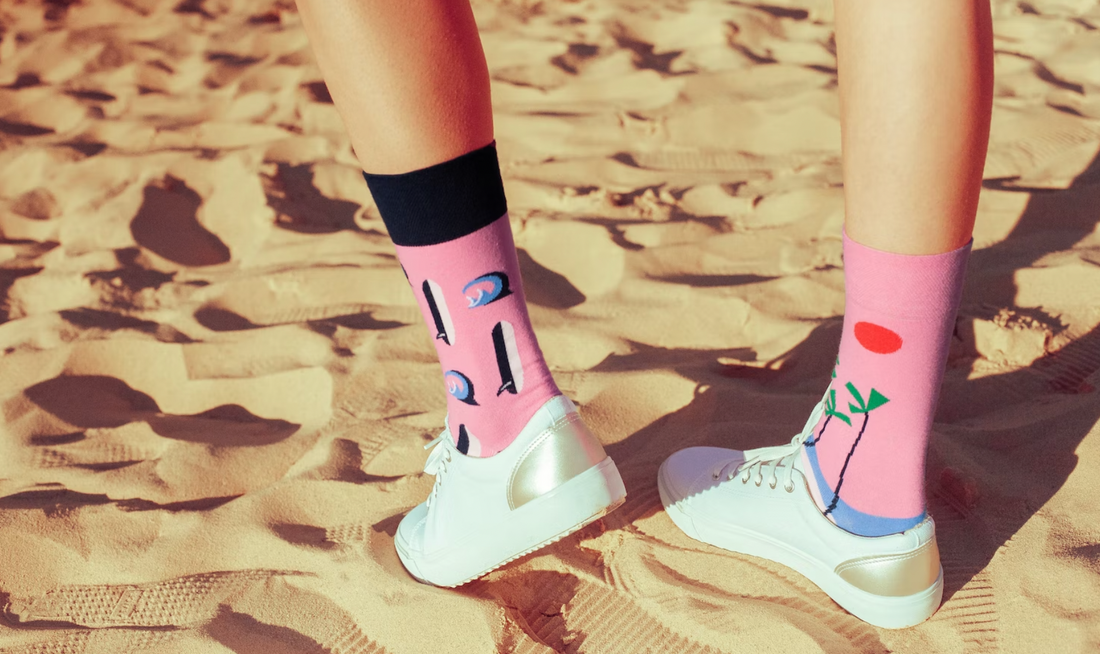If there is one item of clothing that is regularly but wrongly neglected, then it is socks. While sweaters, scarves or hats have a solid reputation as nice gifts, socks are usually seen as an utterly dull way of saying "I care about you". This would only be plausible if good socks weren't actually important. And this perception can only arise if a) you have never felt the pleasure of high quality socks on your feet and b) you completely underestimate socks style factor.
 Photo by Clem Onojeghuo on Unsplash
Photo by Clem Onojeghuo on Unsplash
A sock is not just a sock
Many people don't spend money on high-quality socks. The common reasons for this are: for the most part socks disappear in the shoe anyway, their colours quickly fade and they becom thin after a few wears. But in fact, all of this is not necessarily the case.
Theory 1: Hosiery doesn't matter because you don't see it anyway
Since the lower part of the socks disappears into the shoe and the upper part is usually covered by trousers, the assumption is widespread that the choice of socks has little or no effect on the overall outfit. But that is far from being true. Even if the ankles aren't the first thing that catches your eye, a fitting, high-quality stocking or sock helps completing an outfit. Especially when sitting, our most common body position throughout the day, pants legs slide up and display the socks. If these are worn out or show an odd unmatcing colour, they can completely ruin an otherwise carefully assembled look. But if they match the rest of the clothing in terms of quality and colour, that makes a huge difference. It is only with this attention to detail that thrown together clothing can become a distinguished outfit.

Theory 2: Quality differences in socks are only noticeable in the price
Above all, this statement can only be made by those who have never actively dealt with different sock qualities. In fact, there are many points where higher quality models pay off. The optics is the most obvious point. Even if socks are usually not inspected very closely, the differences in quality in the fabrics are very visible. Good hosiery keeps its shape and doesn't wear out as quickly. They don't pill ("pilling" is what they call when these little balls of fabric form on clothing), are breathable, really soft and comfortable and have a firm but flexible cuff that ensures that the socks don't slip, without squeezing the skin to hard.
Theory 3: High-quality socks are not worthwhile because socks constantly have holes
Socks and stockings are among the items of clothing that are most stressed by use. We stand on them with our entire body weight, with every step they rub against the shaft of the shoes, they are directly exposed to foot sweat and end up in the laundry after each wear. Of course, this affects the material. It is therefore true that socks have a rather short lifespan compared to other clothing items. As with all materials, however, it also applies here that good quality is characterized by longevity, and that proper handling above all helps to be able to wear the socks for a long time.

Keep your toenails short
Three typical mistakes in particular are easy to avoid. First, keep your toenails short. If sock holes appear on the toes again and again, this is a pretty sure sign that your toenails are too long and/or too sharp-edged. Feet deserve care just like the rest of the body. This also includes trimming your toenails regularly, i.e. at least once a week. This not only looks well-groomed, but also maintains foot health, since nails cannot grow in so easily in this way. It also protects the fabric of the socks in the toe area, which brings us back to the topic.
Buy your shoes big enough
A second reason for holes - both on the toe and on the heel are tight shoes. If the toes hit the front of the shoe or if the shoe presses on the heel, then friction and pressure between the foot, stocking and shoe occurs, which causes the material to tire and break.
Get comfortable slippers
And the third reason why socks and stockings wear out after a short time is "walking barefoot" with socks. Going barefoot trains the foot and is generally a pretty healthy thing. However, if the floor is too cold for direct skin contact, socks are usually the way to go. However, it is clear that walking on hard and rough floors takes a toll on the yarn. Under the heel and on the ball of the foot - the places where most of the weight is - it then becomes flimsy faster. That's why it's best to wear special, robust socks when walking barefoot on cold floors. More delicate fabrics profit from a protective shoe sole.

Photo by Billy Fletcher on Unsplash
If you want to be comfortable at home but don't necessarily have to walk barefoot, just put on slippers. This not only extends the life of your socks, but can also look really good. Cool lounge wear together with stylish but comfortable slippers like our comfy Fünve slides ensure that you enjoy maximum comfort on days at home - e.g. in the home office - whilst looking sharp.

In the picture: Turquoise slides "SUNSET"
Cover photo: Photo by Shuhajkov on Unsplash

